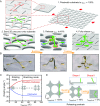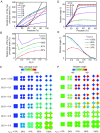Buckling and twisting of advanced materials into morphable 3D mesostructures
- PMID: 31217291
- PMCID: PMC6613082
- DOI: 10.1073/pnas.1901193116
Buckling and twisting of advanced materials into morphable 3D mesostructures
Abstract
Recently developed methods in mechanically guided assembly provide deterministic access to wide-ranging classes of complex, 3D structures in high-performance functional materials, with characteristic length scales that can range from nanometers to centimeters. These processes exploit stress relaxation in prestretched elastomeric platforms to affect transformation of 2D precursors into 3D shapes by in- and out-of-plane translational displacements. This paper introduces a scheme for introducing local twisting deformations into this process, thereby providing access to 3D mesostructures that have strong, local levels of chirality and other previously inaccessible geometrical features. Here, elastomeric assembly platforms segmented into interconnected, rotatable units generate in-plane torques imposed through bonding sites at engineered locations across the 2D precursors during the process of stress relaxation. Nearly 2 dozen examples illustrate the ideas through a diverse variety of 3D structures, including those with designs inspired by the ancient arts of origami/kirigami and with layouts that can morph into different shapes. A mechanically tunable, multilayered chiral 3D metamaterial configured for operation in the terahertz regime serves as an application example guided by finite-element analysis and electromagnetic modeling.
Keywords: kirigami; metamaterials; origami; three-dimensional fabrication.
Conflict of interest statement
The authors declare no conflict of interest.
Figures





References
-
- Pikul J. H., Zhang H. G., Cho J., Braun P. V., King W. P., High-power lithium ion microbatteries from interdigitated three-dimensional bicontinuous nanoporous electrodes. Nat. Commun. 4, 1732 (2013). - PubMed
-
- Sun K., et al. , 3D printing of interdigitated Li-ion microbattery architectures. Adv. Mater. 25, 4539–4543 (2013). - PubMed
-
- Han M., et al. , Three-dimensional piezoelectric polymer microsystems for vibrational energy harvesting, robotic interfaces and biomedical implants. Nat. Electron. 2, 26–35 (2019).
-
- Arpin K. A., et al. , Multidimensional architectures for functional optical devices. Adv. Mater. 22, 1084–1101 (2010). - PubMed
Publication types
LinkOut - more resources
Full Text Sources

